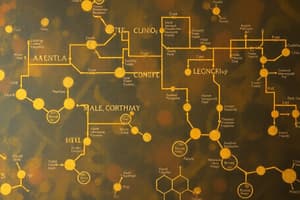Podcast
Questions and Answers
What is the process by which some proteins are converted into glucose during protein metabolism?
What is the process by which some proteins are converted into glucose during protein metabolism?
- Glycogenesis
- Gluconeogenesis (correct)
- Glycogenolysis
- Glycolysis
Which enzyme participates in amino acid deamination in both cytosol and mitochondria to the liver?
Which enzyme participates in amino acid deamination in both cytosol and mitochondria to the liver?
- Pyruvate carboxylase
- L-Glutamate dehydrogenase (correct)
- Citrate synthase
- Lactate dehydrogenase
Which process involves the formation of glucose from non-carbohydrate sources?
Which process involves the formation of glucose from non-carbohydrate sources?
- Gluconeogenesis (correct)
- Glycogenolysis
- Glycolysis
- Glycogenesis
Which of the following is NOT a type of deamination?
Which of the following is NOT a type of deamination?
What is the main function of proteins in the body?
What is the main function of proteins in the body?
Which metabolic process involves the breakdown of foods to gain energy?
Which metabolic process involves the breakdown of foods to gain energy?
Which process in glucose metabolism involves the conversion of glycogen into glucose?
Which process in glucose metabolism involves the conversion of glycogen into glucose?
What is the primary end product of glycolysis?
What is the primary end product of glycolysis?
Which process involves storing the breakdown of glucose as glycogen?
Which process involves storing the breakdown of glucose as glycogen?
Which process involves the breakdown of complex molecules into smaller units without requiring energy?
Which process involves the breakdown of complex molecules into smaller units without requiring energy?
What is the main energy requirement for anabolism?
What is the main energy requirement for anabolism?
Which process involves the synthesis of glycogen from glucose?
Which process involves the synthesis of glycogen from glucose?
What is the primary function of glycolysis?
What is the primary function of glycolysis?
Which process involves the production of glucose from non-carbohydrate sources like amino acids?
Which process involves the production of glucose from non-carbohydrate sources like amino acids?
During which process are complex biomolecules built from simpler components?
During which process are complex biomolecules built from simpler components?
Gluconeogenesis is the process to produce glucose from ______
Gluconeogenesis is the process to produce glucose from ______
Glycogenolysis is the process to convert glycogen into ______
Glycogenolysis is the process to convert glycogen into ______
Glycolysis breaks down glucose to form ______ and ATP
Glycolysis breaks down glucose to form ______ and ATP
Glycogenesis is the process to store the breakdown of glucose as ______
Glycogenesis is the process to store the breakdown of glucose as ______
Carbohydrate metabolism involves the small intestine where monosaccharides are absorbed into the ______ blood
Carbohydrate metabolism involves the small intestine where monosaccharides are absorbed into the ______ blood
Insulin, glucagon, and epinephrine control the concentration of glucose in ______
Insulin, glucagon, and epinephrine control the concentration of glucose in ______
Gluconeogenesis occurs when the glucose level in blood is low and these substrates are needed to genesis new glucose: 1) Amino acids 2) Lactate 3) Glycerol 4) ______
Gluconeogenesis occurs when the glucose level in blood is low and these substrates are needed to genesis new glucose: 1) Amino acids 2) Lactate 3) Glycerol 4) ______
During muscle strenuous activities, pyruvic acid can be converted into lactic acid compared to acetyl CoA because of the lack of ATP produced by glycolysis process. In resting time, lactic acids are converted back into pyruvic acid which then undergoes the ______ process.
During muscle strenuous activities, pyruvic acid can be converted into lactic acid compared to acetyl CoA because of the lack of ATP produced by glycolysis process. In resting time, lactic acids are converted back into pyruvic acid which then undergoes the ______ process.
The conversion of glucose into glycogen by glycogenesis could occur when glucose is not immediately needed, serving as a storage form. This process is opposite to ______.
The conversion of glucose into glycogen by glycogenesis could occur when glucose is not immediately needed, serving as a storage form. This process is opposite to ______.
Gluconeogenesis requires anabolic pathway to synthesize the formation of glucose from amino acids, lactate, and glycerol. It also needs energy to break down ______.
Gluconeogenesis requires anabolic pathway to synthesize the formation of glucose from amino acids, lactate, and glycerol. It also needs energy to break down ______.
Substrate level phosphorylation in glycolysis involves the transfer of phosphate group from ATP to glucose. This is one of the important events in ______.
Substrate level phosphorylation in glycolysis involves the transfer of phosphate group from ATP to glucose. This is one of the important events in ______.
Anabolic pathway is needed in gluconeogenesis to synthesize glucose from non-carbohydrate sources like amino acids, lactate, and glycerol. This process involves the formation of glucose from simpler molecules and requires energy to break down ______.
Anabolic pathway is needed in gluconeogenesis to synthesize glucose from non-carbohydrate sources like amino acids, lactate, and glycerol. This process involves the formation of glucose from simpler molecules and requires energy to break down ______.
Protein metabolism is the process to breakdown foods are used by the body to gain energy. During protein metabolism, some of the protein will be converted into glucose through ______ process.
Protein metabolism is the process to breakdown foods are used by the body to gain energy. During protein metabolism, some of the protein will be converted into glucose through ______ process.
Glycogenolysis is the process of breaking down ______ into glucose.
Glycogenolysis is the process of breaking down ______ into glucose.
The process of converting glucose into glycogen is known as ______.
The process of converting glucose into glycogen is known as ______.
Anabolism is the process in which complex biomolecules are built from simpler components, requiring energy. It is the opposite of ______.
Anabolism is the process in which complex biomolecules are built from simpler components, requiring energy. It is the opposite of ______.
The primary end product of glycolysis is ______.
The primary end product of glycolysis is ______.
During glycolysis, glucose is broken down into ______ molecules.
During glycolysis, glucose is broken down into ______ molecules.
Explain the difference between catabolism and anabolism in terms of energy requirements.
Explain the difference between catabolism and anabolism in terms of energy requirements.
What is the primary purpose of gluconeogenesis?
What is the primary purpose of gluconeogenesis?
Describe the process of glycogenolysis.
Describe the process of glycogenolysis.
Why is anabolic pathway important in synthesizing glucose through gluconeogenesis?
Why is anabolic pathway important in synthesizing glucose through gluconeogenesis?
What is the primary molecule produced at the end of glycolysis?
What is the primary molecule produced at the end of glycolysis?
Explain the role of insulin, glucagon, and epinephrine in regulating glucose concentration.
Explain the role of insulin, glucagon, and epinephrine in regulating glucose concentration.
Explain the process of gluconeogenesis and its significance in glucose metabolism.
Explain the process of gluconeogenesis and its significance in glucose metabolism.
What is the main difference between glycolysis and glycogenolysis?
What is the main difference between glycolysis and glycogenolysis?
Describe the role of anabolism in glucose metabolism.
Describe the role of anabolism in glucose metabolism.
How does insulin, glucagon, and epinephrine regulate the concentration of glucose in the blood?
How does insulin, glucagon, and epinephrine regulate the concentration of glucose in the blood?
Explain the significance of glycogenolysis in the context of energy metabolism.
Explain the significance of glycogenolysis in the context of energy metabolism.
Differentiate between glycolysis and glycogenesis in terms of their metabolic functions.
Differentiate between glycolysis and glycogenesis in terms of their metabolic functions.
Explain the process of deamination in amino acid metabolism.
Explain the process of deamination in amino acid metabolism.
What is the primary function of gluconeogenesis?
What is the primary function of gluconeogenesis?
Describe the process of glycogenolysis.
Describe the process of glycogenolysis.
Differentiate between anabolism and catabolism.
Differentiate between anabolism and catabolism.
What is the main energy requirement for anabolism?
What is the main energy requirement for anabolism?
Explain the role of glycolysis in cellular metabolism.
Explain the role of glycolysis in cellular metabolism.
Flashcards are hidden until you start studying
Study Notes
Protein Metabolism
- Proteins can be converted into glucose through a process that involves deamination and gluconeogenesis.
- The enzyme that participates in amino acid deamination in both cytosol and mitochondria in the liver is unknown.
Glucose Metabolism
- Gluconeogenesis is the process of forming glucose from non-carbohydrate sources like amino acids, lactate, and glycerol.
- This process occurs when the glucose level in the blood is low and requires energy to break down substrate molecules.
- Glucagon, insulin, and epinephrine control the concentration of glucose in the blood.
Glycolysis
- Glycolysis is the process of breaking down glucose into pyruvate and ATP.
- The primary end product of glycolysis is pyruvate.
- Glycolysis is the primary function of cellular metabolism.
Glycogen Metabolism
- Glycogenolysis is the process of breaking down glycogen into glucose.
- Glycogenesis is the process of storing glucose as glycogen, which is the opposite of glycogenolysis.
- Glycogenolysis is significant in energy metabolism as it provides glucose for energy production.
Energy Metabolism
- Anabolism is the process of building complex biomolecules from simpler components, requiring energy.
- Catabolism is the process of breaking down complex biomolecules into smaller units, releasing energy.
- The main energy requirement for anabolism is energy.
Regulation of Glucose Concentration
- Insulin, glucagon, and epinephrine regulate the concentration of glucose in the blood.
Deamination
- Deamination is the process of removing an amino group from amino acids.
- The primary function of deamination is to produce energy from amino acids.
Studying That Suits You
Use AI to generate personalized quizzes and flashcards to suit your learning preferences.




